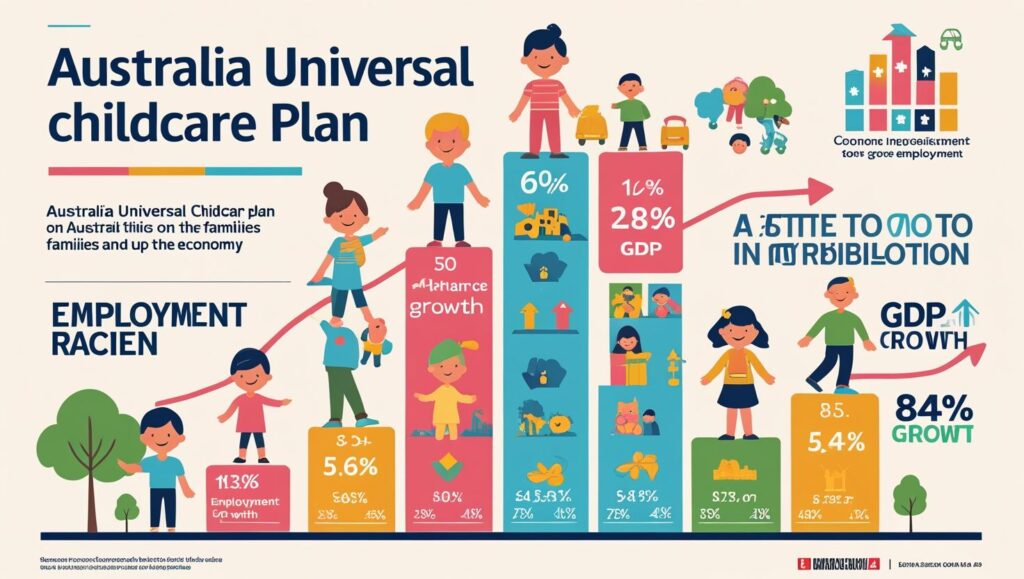
Australia is pushing forward with a bold universal childcare plan despite economic headwinds. Here’s what it means for working families, the economy, and the future of early education.
Introduction
In 2025, as inflationary pressures, rising interest rates, and slowing economic growth test national budgets worldwide, Australia has unveiled an ambitious plan to implement universal childcare. The move has been hailed as a progressive step for working families, gender equality, and early childhood education. Yet, it comes at a time when government spending is under intense scrutiny.
The plan’s rollout has sparked debates in Parliament, heated public discussions, and close attention from economists. Advocates say universal childcare will boost workforce participation and benefit long-term economic growth. Critics warn it may add strain to an already pressured federal budget.
In this in-depth article, we’ll break down:
- What the universal childcare plan includes
- The political and economic context
- Benefits for children, parents, and the economy
- Potential challenges and criticisms
- Global comparisons
- What comes next for Australia
The Core of Australia’s Universal Childcare Plan
The government’s proposal aims to make childcare accessible and affordable for all families, regardless of income. Here are the key features:
- 100% Subsidy for Low-Income Families: Families below a certain income threshold would pay nothing for childcare.
- Scaled Subsidies for Middle-Income Families: The subsidy percentage decreases gradually based on household earnings.
- Price Regulation: Measures to prevent childcare providers from inflating fees after subsidies increase.
- Expanded Early Childhood Education Access: Universal coverage includes pre-kindergarten programs.
- Workforce Development: Training and higher wages for childcare workers to meet increased demand.
This plan builds on Australia’s existing childcare subsidy system but eliminates the “work activity” test that previously excluded some families.
Why Now? The Political and Economic Context
Economic Pressure
Australia is facing:
- Slowing GDP growth (forecast below 2% for 2025)
- Inflation stubbornly above the Reserve Bank’s target
- Rising household debt
- Government budget deficits
Despite this, the federal government sees universal childcare as an investment, not just a cost.
Political Momentum
The ruling government made childcare reform a core election promise. Polling shows strong public support, with over 70% of Australians favoring more affordable childcare.
The Economic Case for Universal Childcare
Economists point to several long-term benefits:
1. Increased Workforce Participation
Many parents, especially mothers, reduce working hours or leave the workforce due to childcare costs. Universal childcare can:
- Boost labor force participation rates
- Reduce the gender pay gap
- Increase tax revenue from higher employment
2. Early Childhood Education as Economic Investment
Studies show that quality early childhood education:
- Improves school readiness
- Reduces future social welfare costs
- Enhances lifetime earnings for children
3. Stimulating the Economy
Increased parental workforce participation and stable childcare employment create a positive economic cycle.
Challenges and Criticisms
Despite its promise, the plan faces significant hurdles:
- Cost: Estimates put the annual price tag at $15–20 billion.
- Childcare Worker Shortage: The sector already struggles with staffing; demand will surge.
- Inflationary Risks: Some economists worry about increased government spending amid high inflation.
- Regional Access: Rural and remote areas may lack enough childcare facilities to meet universal demand.
Global Comparisons
Australia is not alone in pursuing universal childcare. Countries like Norway, Sweden, and Canada have implemented similar systems with notable success. However:
- Scandinavian models rely on high taxes and strong public sector capacity.
- Canada’s system is still in early rollout stages, facing long waitlists.
These examples show that execution and funding stability are key to making universal childcare work.
The Human Side: Stories from Families
For working parents, the change could be transformative.
“Right now, I pay more for childcare than my mortgage,” says Sarah, a Sydney mother of two. “Universal childcare would mean I can work full-time without feeling financially punished for it.”
For others, it means greater flexibility, career advancement, and reduced stress.
What Happens Next?
The plan is set for phased implementation over three years, starting in 2026. The government will:
- Pass enabling legislation
- Negotiate with states and territories
- Expand childcare worker training programs
Conclusion
Australia’s bold universal childcare plan is a historic social and economic policy shift. While challenges in cost, workforce capacity, and inflation risk remain, the potential benefits — from gender equality to long-term economic growth — make it a transformative move.
For families, it’s not just policy — it’s a lifeline for better work-life balance and economic security.
External Reference
For more details on government policy documents, visit the official Australian Department of Education website for updates.

